#3d food printing market
Explore tagged Tumblr posts
Link
#pioneering marketdigits consulting and advisory private limited#3d food printing market#global 3d food printing market#3d food printing market trends#3d food printing market shares
0 notes
Text
3-D Food Printing Could Change How We Eat

If you thought 3-D printers were only meant for the manufacturing industry – printing out high precision machine parts, toys, jewellery, etc – well, it is time to think again. But there is a new frontier in 3-D food printing that’s only beginning to come into focus... READ MORE
ALSO READ Significance of Barcode in Food Packaging Good Manufacturing Practices in Food Industry How to Find a Mouth-Watering Brand Name for Your Food Business For many more such articles you may visit PFIonline.com
0 notes
Text
3D Food Printing Market Trends, Share, Size, In-Depth Analysis, and Forecast to 2027
The global 3D food printing market size was reasonably estimated to be approximately $201 million in 2022 and is poised to generate revenue over $1,941 million by 2027, growing at a CAGR of 57.3% from 2022 to 2027. The global market is highly impacted by innovations, as manufacturers are always introducing new processing techniques to produce complex food products of different shapes and sizes, thereby focusing on catering to the increasing demand from the processed food industry and consumers.

Development of new machinery and enhancement of the existing ones are the key strategies adopted by many players in the market. In addition, increasing focus on the expansion of facilities, marketing schemes, and information exchange programs to create awareness and enhance the applications of 3D food printer is projected to contribute to the growth of the market.
Download PDF Brochure: https://www.marketsandmarkets.com/pdfdownloadNew.asp?id=267692011
COVID-19 outbreak jeopardizes food security and nutrition from a variety of perspectives, including food chain disruption, food shortages, reduced purchasing power, unhealthy eating habits, increased food loss, and an increase in unemployment and underemployment. Furthermore, the lack of socializing with friends, colleagues, parents, and others while eating has resulted in stress, anxiety, fear, anguish, and worry, which has exacerbated the negative effects of COVID-19 on the health status of all people, particularly vulnerable consumers such as the elderly and hospitalized patients. 3D food printing has unrivaled and unique potential, allowing for personalized food manufacture, social distancing, decentralization of food manufacturing, people participation in food co-creation, socializing the process, and creating new businesses and jobs. These new ideas should assist in considerably reducing the spread of COVID-19, as well as the threats to people’s health and negative consequences for food security and society.
To begin with, 3D food printing maintains social distancing as required by regulations in the food site area due to its nature as a computer-aided technology. When generating, sculpting, testing, validating, and manufacturing food products, 3D food printing may reduce the number of people touching food before consumption, as well as inter-human contact. Furthermore, 3D food printing significantly supports food decentralization, allowing for a reduction in the number of persons participating in the food chain and thus a reduction in food contact. Lean manufacturing and just-in-time production, distribution, and storage strategies have formulated a low-cost food system, but the unusual and widely dispersed stresses of the pandemic economy unfolded the inability of this kind of system to respond quickly to disruptions that are far outside the normal range.
Opportunities: Growth in demand from the hospitality industry
The hospitality industry has shown huge interest in 3D food printing technology. The capability of the 3D food printers to print food in various complex designs, which is not possible manually, has gained the attention of many famous chefs around the world. According to the companies offering 3D food printers, it would provide chefs an opportunity to present food with various complex designs, which was not possible through the traditional preparation methods. Although the idea of the companies offering 3D food printers to replace microwaves with 3D food printers for household uses is far from reality, the users are likely to prefer to have food in various designs sometimes for fun. Thus, the hospitality industry is expected to provide ample opportunities for the 3D food printing market.
Make an Inquiry: https://www.marketsandmarkets.com/Enquiry_Before_BuyingNew.asp?id=267692011
Challenges: limitations in processing different ingredients hamper usage of 3D printers
Limited availability of food ingredients is the major challenge that 3D food printer companies face. The 3D food printer cannot be commercialized on a large scale due to the unavailability of all the necessary food ingredients. The big market players, such as Barilla (Italy) and Nestlé (Switzerland), associated with the food industry are working with 3D food printer manufacturing companies to develop ingredients of different nutrient composition for 3D food printers. This is not an easy task, as the companies have to extract polymers from the food items that need to be printed, which are not easy to extract and require extensive research in this area. Thus, although the companies seem positive and excited about this new technology of 3D food printing, the prospects of the market depend on how soon they come up with various options for consumers.
Different countries across the globe have different food cuisines, and consumers in these countries prefer different food products made up of different ingredients. 3D food printers are highly specific in terms of food processing, ingredients, and final products. This is a challenge for players in the market, as they need to develop 3D printers that cater to consumers’ needs in regions such as Asia and Africa. Similarly, there is also a need for the production and availability of ingredients that can be used to produce these different cuisines. Another similar challenge is that not every type of food can be food-printed. Food that is not strong enough to be filed is not appropriate for 3D printing. Food printers should go beyond the printing of shapes to printing food textures, both existing and new.
Request for Sample Pages: https://www.marketsandmarkets.com/requestsampleNew.asp?id=267692011
The North American market is estimated to dominate the 3D food printing market in 2022
North America is estimated to account for the largest market share in the 3D food printing market in 2022. The presence and growth of the companies offering 3D food printing technology in this region are boosting the market in this region. This region is projected to be the largest market during the forecast period.
The US is known as one of the early adopters of new technologies in the world. The busy and fast-moving life of common people make it hard for them to get a proper nutritious diet. The 3D food printing technology could provide an option to have customized, nutritious food. Also, the US government spends the highest amount of budget on healthcare, and the benefits of 3D food printers to provide food rich in specific nutrients and with the ease of chewing and swallowing would provide a suitable option for feeding the elderly.
This report includes a study of marketing and development strategies, along with the product portfolios of the leading companies in the 3D food printing market. It includes the profiles of leading companies such as 3D systems (US), TNO (Netherlands), NATURAL MACHINES (Spain), Choc edge (UK), Systems & Materials Research Corporation (US), byFlow B.V. (Netherlands), beehex (US), CandyFab (US), ZMORPH S.A (Poland) and Wiiboox (China).
#3D Food Printing Market#3D Food Printing#3D Food Printing Market Size#3D Food Printing Market Share#3D Food Printing Market Growth#3D Food Printing Market Trends#3D Food Printing Market Forecast#3D Food Printing Market Analysis#3D Food Printing Market Report#3D Food Printing Market Scope#3D Food Printing Market Overview#3D Food Printing Market Outlookl#3D Food Printing Market Drivers#3D Food Printing Industry#3D Food Printing Companies
0 notes
Text
Global 3D Food Printing Market Trends and Analysis through 2028

Unlock the potential of the 3D Food Printing Market on a global scale. Analyze the trends and opportunities in the ever-expanding Global Food Printing Market.
#3D Food Printing Market#Global Food Printing Market#3D Food Printing Market Future#3D Food Printing Market Analysis#3D Food Market
0 notes
Text
Key Trends Shaping the 3D Food Printing Market
The global 3D food printing market size was reasonably estimated to be approximately $201 million in 2022 and is poised to generate revenue over $1,941 million by 2027, growing at a CAGR of 57.3% from 2022 to 2027. The global market is highly impacted by innovations, as manufacturers are always introducing new processing techniques to produce complex food products of different shapes and sizes, thereby focusing on catering to the increasing demand from the processed food industry and consumers.Development of new machinery and enhancement of the existing ones are the key strategies adopted by many players in the market. In addition, increasing focus on the expansion of facilities, marketing schemes, and information exchange programs to create awareness and enhance the applications of 3D food printer is projected to contribute to the growth of the market.

Download PDF Brochure: https://www.marketsandmarkets.com/pdfdownloadNew.asp?id=267692011
Drivers: Bourgeoning demand for gourmet food
3D food printing provides the ability to personalize food according to individual needs. The increasing market for customized food is a major reason for the growth of the 3D food printing market. The advancement in technology has made people busier with their work, and they often fail to experience their favorite food due to the shortage of time. This gives rise to the market for customized food; however, the customized food items need to be mixed with appropriate preservatives to keep them fresh. Frequent consumption of preservatives is not good for health in the long run. Thus, 3D food printing technology provides an option to have homemade freshly cooked food for the users.
The 3D food printer can print food in different complex designs, which is not possible manually. A 3D food printer comprises a food-grade syringe or cartridge that holds material, a real food item, and deposits exact fractional layers through a food-grade nozzle directly onto a plate or other surface in a layer-by-layer additive manner. This food can be a source of a healthy diet for children and adults who want to indulge in food such as chocolate, pizza, and pancakes in unique shapes and designs.
The commercial segment is estimated to account for the largest share in the global market in 2021
By vertical, the commercial segment is estimated to account for the largest share in the market in 2022. Commercial segment is estimated to witness growth due to major demand of 3D printed food can be served through baking industry, restaurants, confectionaries and retail store. The companies are working on their products to make them more efficient so that they would be able to provide more options for customized food to the customers. For a instance, BeeHex, the company manufacturing the 3D pizza printers, has demonstrated the use of their Chef3D food printer to print pizzas in various shapes. Thus, the ability of 3D food printers to print food in complex designs to provide customized food would drive the market for 3D food printers in coming years with the developments in technology.
Request for Sample Pages: https://www.marketsandmarkets.com/requestsampleNew.asp?id=267692011
The Asia Pacific market is projected to grow at the highest CAGR during the forecast period
The market in Asia Pacific is projected to grow at the highest rate with the reducing cost of the technology in the coming year. Countries such as China, South Korea, and Japan are working actively in the 3D food printing market, signifying the promising future for 3D food printing technology in the coming years
Key players in this market include 3D systems (US), TNO (Netherlands), NATURAL MACHINES (Spain), Choc edge (UK), Systems Materials Research Corporation (US), byFlow B.V. (Netherlands), beehex (US), CandyFab (US), ZMORPH S.A (Poland) and Wiiboox (China)
0 notes
Text
3D food printing Market Research to Grow a CAGR during 2023 to 2032
Market Overview
The 3D food printing market has been making significant strides in recent years, revolutionizing the way we prepare and consume food. This innovative technology combines 3D printing and food science to create intricate and customizable edible designs, making it a fascinating field with tremendous potential. In this article, we will delve into the current trends, opportunity analysis, industry segmentation, outlook, types, growth drivers, and demand dynamics of the 3D food printing market.
The 3D food printing market report has seen impressive growth due to increasing consumer demand for personalized and nutritionally optimized foods, the need for sustainable food production, and the constant drive for culinary innovation. The market is set to expand further as technology evolves and the ecosystem matures.
3D food printing Market Size was valued at USD 0.18 Billion in 2022. The 3D food printing market is projected to grow from USD 0.28 Billion in 2023 to USD 10.9 Billion by 2032, exhibiting a compound annual growth rate (CAGR) of 57.90% during the forecast period (2023 - 2032)

Trends and Market Opportunities
Customization and Personalization: Customization is one of the defining trends in the 3D food printing market. Consumers seek individualized food experiences, whether it's a birthday cake with a unique design, personalized nutrient profiles, or tailored dietary solutions. 3D food printing enables chefs and consumers to create and modify their food based on personal preferences, allergies, or nutritional needs.
Sustainable and Alternative Ingredients: Sustainability is a growing concern in the food industry, and 3D food printing can contribute to reducing food waste and using alternative ingredients like plant-based proteins. This trend aligns with the growing demand for eco-friendly, ethical, and plant-based food products.
Culinary Innovation: The use of 3D food printing is rapidly expanding in high-end restaurants and culinary labs. Chefs and food scientists experiment with creating visually stunning and texturally complex dishes that were previously impossible to achieve with traditional cooking methods.
Pharmaceutical and Healthcare Applications: Beyond gastronomy, 3D food printing is also making headway in the pharmaceutical and healthcare sectors. Customized food solutions for individuals with specific dietary or medical needs, such as dysphagia patients, are being developed, opening up new opportunities for the market.
In-Home 3D Food Printing: As 3D printers become more affordable and user-friendly, there is an emerging market for in-home 3D food printers. This could lead to a revolution in the way people cook and consume food, allowing for greater creativity and control over their diets.
Request for free sample copy: https://www.marketresearchfuture.com/sample_request/11953
Industry Segmentation
The 3D food printing market can be segmented into the following categories:
Technology Type:
Extrusion-based printing
Inkjet-based printing
Binder jetting
Laser-based printing
Powder-based printing
Syringe-based printing
Food Materials:
Chocolate
Meat
Dairy
Pasta
Confectionery
Fruits and vegetables
Bakery products
Others
End Users:
Foodservice industry (restaurants, bakeries, etc.)
Residential
Healthcare
Culinary education
Others
Growth Drivers and Challenges
Growth Drivers:
Increasing consumer demand for personalized food products.
Advancements in 3D printing technology.
Sustainability concerns and the need for efficient food production.
Collaborations between food scientists and technology experts.
Expanding applications in healthcare and pharmaceuticals.
The 3D food printing market trend is experiencing a significant upward trend. As technology continues to advance, 3D food printing is becoming more accessible and innovative. This trend is driven by a growing demand for personalized and sustainable food options. Consumers are increasingly looking for customized meals, and 3D food printing allows for precise control over ingredients and portion sizes. Additionally, the technology has the potential to reduce food waste and enhance culinary creativity. As a result, the 3D food printing market is expected to continue its growth in the coming years, revolutionizing the way we prepare and consume food.
Challenges:
Cost and complexity of 3D food printers.
Regulatory and safety concerns.
Technical challenges, such as achieving the right texture and taste.
Limited consumer awareness.
Intellectual property issues related to food designs.
Market Outlook and Future Prospects
The 3D food printing market is poised for substantial growth in the coming years. As technology becomes more accessible and regulations evolve, we can expect the market to expand its footprint across various sectors. Customization, sustainability, and culinary innovation will remain key driving factors.
Key Players are:
3D Systems, Inc, Aniwaa Pte. Ltd, Barilla America, Inc, BeeHex, BIOZOON GmbH, Byflow B.V, Candyfab, Choc Edge, Dovetailed, Modern Meadow, NATURAL MACHINES, Netherlands Organization for Applied Scientific Research, ORD Solutions Inc, PancakeBot LLCPrint2Taste GmbH, and Wiiboox.
Related Reports:
Dairy-Free Cream Cheese Market Research Report Information By Flavor Type (Flavored and Plain/Unflavored), Ingredients (Soy, Almond, Coconut, and Others), By Nature (Organic and Conventional), Demographic (Gen X, Gen Z, Millennials, and Baby Boomers), End User (Food Processing, Food Service, and Food Retail), Distribution Channel (Supermarkets & Hypermarkets, Specialty Stores, Convenience Stores, and Online) And By Region (North America, Europe, Asia-Pacific, and Rest of the World) - Forecast Till 2032
Food Spreads Market Research Report Information Product Type (Honey, Chocolate-based Spreads, Nut- and Seed-based Spreads, Fruit-based Spreads and Other Product Types), Distribution Channel (Supermarkets/Hypermarkets, Convenience Stores, Online Retail Stores and Other Distribution Channels) and By Region (North America, Europe, Asia-Pacific, and Rest of the World) –Market Forecast Till 2032
About Market Research Future:
Market Research Future (MRFR) is a world-renowned market research company that offers a wide range of services, complete with accurate and precise analysis about diverse markets, sub-markets and target consumers. Our approach is a combination of extensive information and multiple data sources that help provide an exhaustive comprehension about the latest major developments to the client, in addition to future events and what measures and decisions to take on the basis of the same.
Our fast-emerging market research firm is armed with an adept research analysts’ team that focuses on gathering useful data and analytics in terms of economic and technological advances. Our proficient analysts conduct industrial visits in a bid to achieve reliable and accurate information from established market participants. One of our foremost objectives is to keep the client well-versed with all the lucrative opportunities as well as challenges surrounding various global markets. We offer step-by-step guidance to our clients, through consulting and strategic services, enabling them to arrive at a practical and effective decision.
Contact us:
Market Research Future (part of Wantstats Research and Media Private Limited),
99 Hudson Street,5Th Floor, New York, New York 10013, United States of America
PH no.: +1 646 845 9312
Email: [email protected]
#Food Printing Market Application#3D Food Printing Market Region#3D Food Printing Market Research#3D Food Printing Industry
0 notes
Text
#Food 3D Printing Market#Food 3D Printing Market size#Food 3D Printing Market share#Food 3D Printing Market trends#Food 3D Printing Market analysis
1 note
·
View note
Text
The global economy experienced heavy headwinds throughout 2019-2021, as some countries witnessed subdued growth, while others grappled with economic slowdowns. The COVID-19 pandemic has levied undue pressure across industries globally and caused a major economic crisis in the US, India, Italy, the UK, Germany, India, Japan, South Korea, the UK, and many others. Besides, the UK's exit from the European Union in 2020 and the Russo-Ukraine war in 2022 exacerbated global uncertainty.
0 notes
Text
How did you spend your Tuesday evening? For me it was the usual same ol' routine. Getting fucked up on 3D-printed recreational elephant tranquilizer, and watching the out-of-work circus acrobats at the flea market kick the shit out of each other behind the dumpster with Devil Sticks.
I love the flea market, and not just for the freak battle. It's got a great cross-section of humanity, all coming there to argue that a $25 wood plane should be a $20 wood plane. In recent years, though, this proletarian appeal has started to wane. A lot of the booths have been replaced with expensive handmade art, and the food court now has received – and passed! – a health inspection. All this means that there's less opportunity for deals on cool old junk, which is my entire reason for existence.
In the time we have left before the flea market is completely converted to luxury condominiums sitting atop a "farmer's market" selling $35 jars of honey, I must be sure to make the most out of its unique social appeal. Hence the circus acrobats, which to their credit are not out of work because they were fired.
Timmy and Tommy were in fact abandoned by the circus, because their ringmaster is notoriously conflict-averse and simply did not want to tell them that they were flagged as "unwanted" by the carnival investment group. This does not lessen their aggression towards one another in any way. It does, however, make them about as unemployable as yours truly, which means we can be great friends. They're there all day, and sometimes they give me a call when Old Man Johanssen puts out a fresh batch of slightly dented hubcaps at his table. For this vigilance, their only price is the occasional food-court churro, which is now guaranteed by the municipal government to contain less e.coli than you would expect.
What will happen to them when the flea market fades? I asked them this last Tuesday, and through the haze of pachyderm pacification prescriptions, they told me that by then they plan to have started their own circus. Get revenge on those who ditched them, and all that. If the plan doesn't work out, though, they can always go back to their first love: investment banking.
149 notes
·
View notes
Text
Let's talk about Toys in Cereal


This is a part of several posts of mine that have gotten big, but I figure it's best to address the phenomenon itself in a new post.
If you want to just browse a ton of cool old cereal toys once we're done, go to: www.cratercritters.com. It's a neat site.
Cereal toys are a long-standing American tradition. Some tag-questions asked if they went away because of greed or because of regulations, and that's complicated.
There are food regulations that complicate things. You may have heard that Kinder Eggs are not legal in the US.
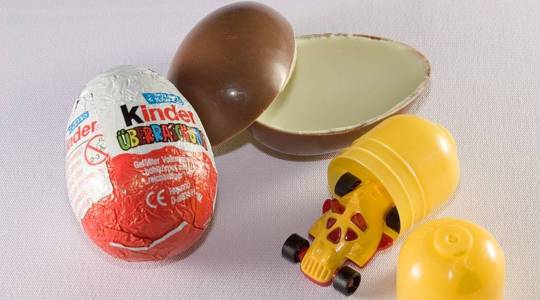
This is usually framed as a "fear the stupid American Kids will eat the toy" kind of thing. This is not the case.
The actual regulation that blocks the Kinder Egg is about food safety from bacterial and undisclosed allergen contamination. Inserting a baggie with a toy into that exposes everything in the cereal bag to the outside of the toy package, and that's a no-no in the US market. The rare thing we're more strict about than the EU.
But that doesn't affect cereal toys, because they can get around it by having it in a separate package outside the food bag, between the inner back and the cardboard box. Much easier on the parents to find when you open the box, too.
Kinder has, themselves, addressed the US Kinder Egg problem the same way, with the Kinder Joy.
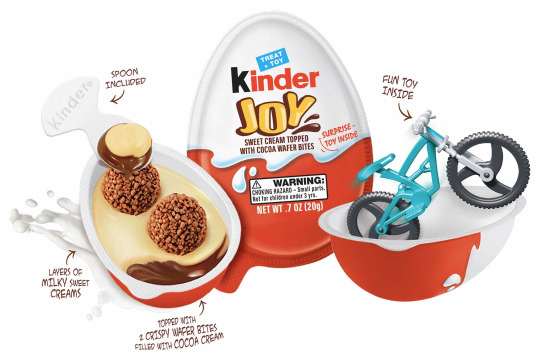
Splitting the package. into two sections that are individually sealed.
But a big blow to the practice was the end of the Australian R&L Toy Company.

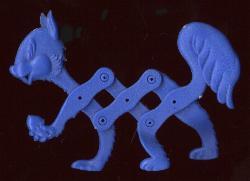
R&L made tons of simple pack-in Premium toys from the 60s through the 80s. They were the primary supplier to Kelloggs, and made everything from simple one-piece figurines to little build-yourself-action-toys.
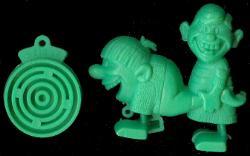

For instance, these "Wacky Walkers" worked by tying a string to the figure and the weight, then dropping the weight off a table. The figures would hobble forward on their feet, pulled by the weight. Neat-o!
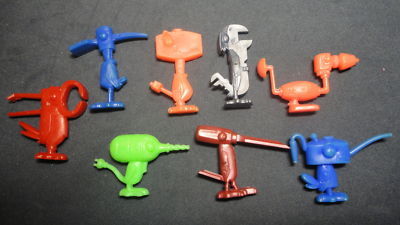
Then there's stuff like these Toolybirds. I'd sell any one of you to the goblin king for a set of these, because I sure can't afford them at $25 apiece or more. I'll probably just make some dinosaur-knockoff version or somesuch to 3d print, eventually.
R&L went out of business in the 80s and its molds were sold to a toy manufacturing company in Mexico that produced their stuff as bag toys for awhile, before everything just faded away.
Meanwhile, the cereal market was forced to contract elsewhere without a devoted company doing essentially just that.

Liscenses came to the rescue. Fun fact, if you wanted toys from most of the Disney Afternoon, your only hope was Kellogg's.
As time went on, you started even getting software in cereal.

Chex gave out a free, PG-version of DOOM for free. Not a couple of demo levels, a whole game, run on the doom engine, with aliens you zap with a spoon.
But as time went on, companies got less and less into the idea of enticing with freebies, and parents started objecting to the marketing of sugar cereals with toy surprises, because given the opportunity, most parents will blame the company for making something the kid wants for their unwillingness to say "No."
The eternal conflict:
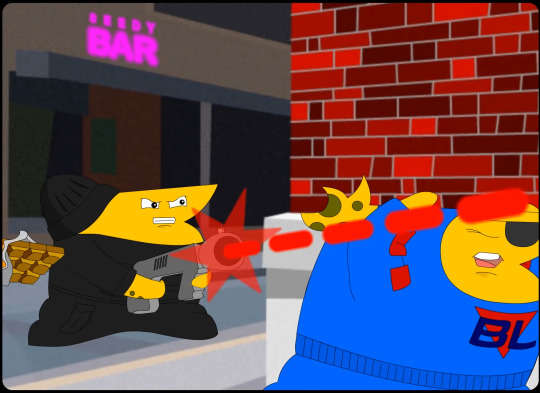

Cool thing the kid would enjoy that you might have to put your foot down over because enforcing moderation is a parent's job, verses unobjectionable conformist mush designed to increase your kids' "goodness levels."
I think the banning of cartoon mascots for snacks in certain countries is also ridiculous.
Thing is, any company could bring them back at any time.

The Monster cereals did figurines of their mascots in cosplay in 2021. Of course, they did it as a limited edition bullshit thing where the actual monster cereal mascots were chase figures, but they made them, they could do them at any time if they wanted to.
They could bring the magic back. Nothing is stopping them.
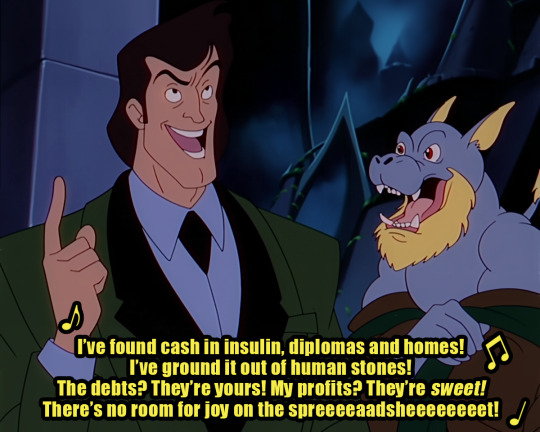
'cept there's no room for joy on the spreadsheet.
Gotta hit you with a little ennui. It's that ambergris stink that makes the perfume truly sweet.
199 notes
·
View notes
Text
Tired Webcomic Creator Noises
Gags … ah yes lets make art into mindless content spat out by Ai cos we've been literally killing creators with inhumane workloads to spit out as many episodes as possible for mindless consumption.
I make my comics with passion and love of the craft! I have a degree in Comics, I spent years...years learning, practising, experimenting, adapting. I recall the days where you may get a page a week, or a few at the start of the month back in the 2000s era of self hosted webcomics and smackjeeves. (Rant below)
I've had to learn how the whole scrolling format worked to adapt to where all the readers had gone to, having been taught the traditional print page formats. And now cos its suddenly a massive money maker for these few hosts and they've pushed creators to the brink with the sheer volume they want pumped out that of course they want to use AI.
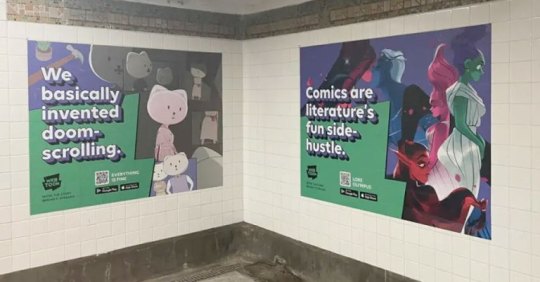
But it will speed up colouring! I have multiple tools available by the software I use and made by the wonderful people who love creating that colouring isn't that much of a chore, Its my fav part honestly. And its also a job sector within comics, colourists are skilled artists and this is another way to trim the fat, to pocket more money and keep churning out the 5th millionth villainess story.
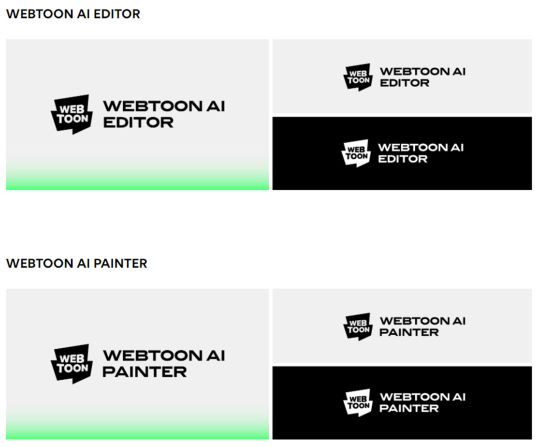
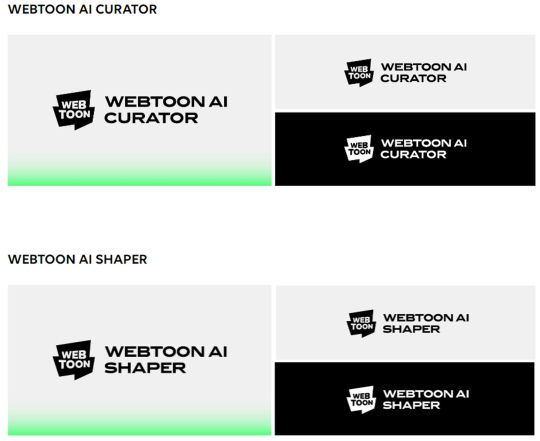
Yes I am in most views a tiny creator, I haven't even broken their 1000 sub goal to even try applying for ad rev in the near 5 ish years on webtoon. But what I make I love, I spend hours researching folklore, scripting, drafting the whole kabudle like many other creators. And other than the kind supporters on my Patreon and Ko-fi I don't make much from the hours, days, weeks I pour into what I make. But at least I know its made with my own hands. That its made with love as corny as that sounds.
Ai is creeping its tentacles into everything, now ethically trained ai tools to help smaller creators would be fine. Most creators already rely on 3d tools to speed up things like backgrounds for webcomics. But when we don't know what its trained on, and is marketed wholesale as something anyone can use to make "content" is where it gets insidious. I am all for anyone with the desire to create and tell a story to go out there and do so, whether a beginner or a master. Part of the joy of a long running webcomic is seeing the artist grow both artistically and literary. But with ai it will be all one homogenous style, a copy of what ever is the hot thing. We already have amazon stuffed to the teeth with ai generated books, videos, merch and more all to be sold in some get rich quick manner. (need I point at the Willy's Wonderland incident). Youtube videos being spat out by faceless accounts stealing and regurgitating content at the speed no human video making team can easily match without cutting out quality or fact checking.
It is tiring. Creatives as a whole are treated poorly for decades, and now with the rapid late stage capitalism, website /social media enshitification and the blind headlong rush into the next big money making thing (watches the nft crash). I can't deny Covid sped this up, as everyone was locked inside and turned to what we creators made for comfort. But that content eating boom, lead to more demand, faster output and tighter budgets. We are seeing journalists being cut, game designers in their thousands and recently Dreamworks cutting a bunch and pushing to make their Robot film come out sooner due to public demands.
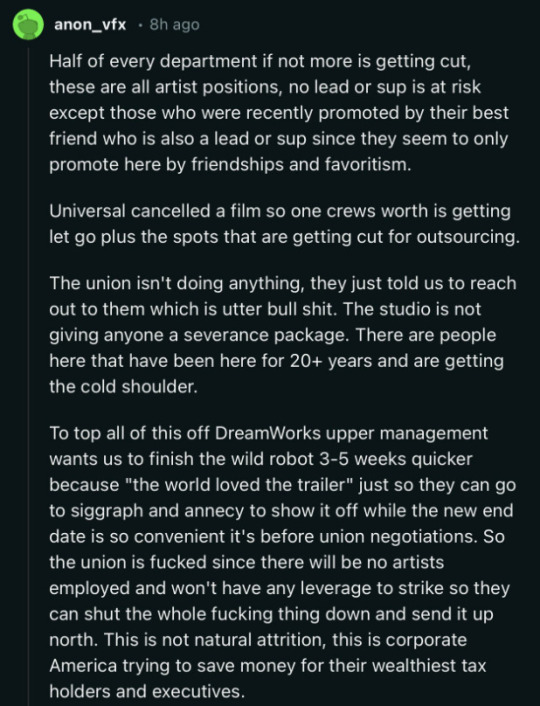
Skilled creatives are being treated like disposable fast food restaurant employees. Used til they burn out, get injured and even die! And then are simply replaced.
I've never been a creator with huge ambitions to work at places like DC, Marvel or Top Cow. I simply wished to create and share stories with the world, to bring smiles, to create art that evokes emotions, inspires others to look around themselves and create too.
Art is for everyone. You just need to take that scary jump, there is a whole array of welcoming communities willing to teach and share. I wouldn't have improved so much without the kindness of the webcomic groups I've discovered and learnt from. Everyone is always learning, and there no shame in not knowing how to do a thing. Even I started with the cheesy how to draw books as a kid and made my own pokemon and digimon.
Don't let the world treat your art as content. It is "ART" as much as what's kept in the louvre is seen as art, so is that little stick man doodle on a postit.
So Try something new, try a new material, a new style.
And support the artists you enjoy, tip their Ko-Fi, pledge to their Patreon, buy a sticker or print. Share their posts and tell them what you love about what they make.
Don't let machines steal away the art in HEART.
25 notes
·
View notes
Text

EVENT 002: BROOKLYN ART FESTIVAL.
The Brooklyn Art Festival has finally arrived! This three-day festival is located in the heart of Brooklyn, and aims to bring the community together through a multi-day offering of live music, artistic demonstrations, creative cuisine, and, of course, a sheer love of art. Volunteer-run, guests of all ages are welcome to join in this celebration of culture, creativity, and community. Admission to the event is free, though amenities including food, drinks, and marketplace offerings will be available for purchase. Street closures will be in place for the event; there is no public parking, but there will be a designated address for rideshare pick-up and drop-off. Walking, biking, and public transportation is highly encouraged!
DAYTIME FESTIVITIES (11AM - 6PM)
CHALK WALK — Stand and watch as professional chalk artists create jaw-dropping displays only utilizing chalk, or join in on the fun and create your own chalk masterpieces! All ages welcome. COMMUNITY MURAL — Leave your mark on a massive paint-by-number interactive mural! Grab a small tin of paint, a paintbrush, and a number, and do your best to stay in the lines. The end result (a beautiful abstract design of the Brooklyn Bridge, as designed by a local Brooklyn-born artist) won’t become evident until the end of the festival, so be sure to stop by on the last night to see what you’ve helped create! KIDSFEST (11AM-3PM) — Engage in all things fun at the kid-friendly kidsfest! Dance parties, inflatables, face painting, fairy hairstyling, elaborate puppet shows, and creative activities such as slime, tie-dye, ceramic painting, and puppet-making stations will be available. Though kid-aimed, all ages are welcome to engage in the fun! SKETCH 101 — You don’t need to be an expert to create a work of art, and the Sketch 101 sessions are here to prove that to you! Novices and professionals alike are all invited to sit and sketch as professional artists walk the audience through step-by-step instructions on how to draw beloved animated characters! Time slots: 12pm (Snoopy); 2pm (Mickey Mouse); 4pm (Shrek). ARTIST MARKET — Give back to the community by visiting the artist market! Featuring over 130 art vendors, there’s sure to be something there for everyone! Paintings, jewelry, ceramics, metalwork, glasswork, photographs, sculptures, watercolor, 2D and 3D art, fiber, prints, and much more will be available for purchase! COLORFUL CUISINE — During the day, make sure to visit one of the many food trucks and vendors available throughout the festival! Along with their typical menus, each vendor features at least one specialty treat in honor of the festival. From art palette cookies to minimalist trifles to deconstructed sandwiches, the food is sure to be a treat for the eyes and mouth! LIVE ENTERTAINMENT — Small stages have been assembled for the express purpose of demonstrating the amazing collection of performance art styles enjoyed by the borough! Take a picture of the schedule, and make sure to stop by each stage to experience a collection of entertainment ranging from rock bands, theatrical groups, opera singers, and more!
COME ALIVE AT NIGHT (6PM-10PM)
GALLERY WALK — The vibrant Brooklyn art scene is shown in all its glory at the nightly gallery walk. Grab a map and take a stroll through the borough, visiting designated ArtSpots: art exhibits hosted at local galleries, retailers, and restaurants. Enjoy light refreshments, striking artwork, and good ambiance. LIVE ENTERTAINMENT — The tempo slows down and the music continues through the night! A small selection of MusicSpots are also available, conveniently along the streets as patrons make their way through the Gallery Walk. Providing the perfect ambiance to the artist experience, be sure to stop and enjoy the music as you stroll from gallery to gallery! STUDENT SCHOLARSHIP SHOWCASE — Art students across Brooklyn have submitted some of their best work to the Brooklyn Art Festival’s Student Showcase! On display at the Haze Gallery (a featured ArtSpot) guests are invited to observe the art and submit a vote on which one piece of art impacted them the most. The artist who created the piece with the most votes at the end of the festival will be granted a small $2K scholarship to help support their artistic endeavors. BUBBLY BOOZE — The festival becomes an open container entertainment zone at night, and guests 21 and older are invited to taste an array of bubbly specialty booze made special for the festival! Each ArtSpot will have a specialty cocktail available, while a small selection of the daytime’s food vendors will return for the night’s light installation (along with a newly available nighttime cocktail). LIGHTS UP PERFORMANCE (9:30PM) — End your night with a synchronized light and music performance at Prospect Park! Light installations have been created and installed in the park, programmed to a musical arrangement that professional dancers have choreographed a routine to. Grab some food and something to drink, sit back, and watch as light, music, and dance all combine in dazzling collaboration!
OOC DETAILS BELOW!
OOC DETAILS.
IC Timeline: Canonically, the art festival occurs over the weekend, from May 10th — May 12th. OOC Timeline: Members will have between May 10th through May 17th to post their initial starters for the festival. After 5/17, no new starters are permitted, but members are free to continue their ongoing event threads until their natural conclusion. An announcement will be made on both days when the event has started and ended. Involvement: The Brooklyn Art Festival is organized by a nonprofit and run almost entirely by volunteers. All artists involved — asked to lead a Sketch 101 class, performing on a stage, featured in an exhibit, etc. — do so either voluntarily, or only for a small sum of money despite their professional status. As such, characters are welcome to both be guests of the event, or volunteers manning a booth, performing on a stage, hosting or featured in a gallery, or anything in between! Threads: Members are highly encouraged to engage in any art festival related threads during this time, and are free to continue non-event threads as well! Just please be sure to tag all event threads as bhqevent002 for differentiation purposes.
If you have any other questions about the event, please do not hesitate to reach out to the main!
#boroughs.event#bhqevent002#boroughs.announcement#finally here after being push back a month!!! <333
9 notes
·
View notes
Text
The "nerdy" store at the bigger mall never has Rick and Morty merchandise--I found a DVD there once, but that's it--and yesterday was no exception. I did find a cardboard cutout of Sersi, my favorite Eternal:
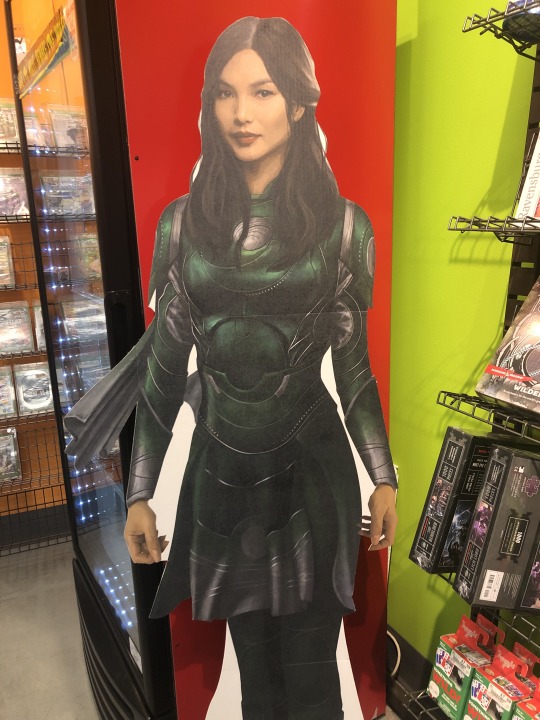
Am I the only one who liked Eternals? I think Marvel just marketed it badly.
I usually don't have much luck at Hot Topic, either. They sell bags of tiny figurines from other shows, and I always wondered why Rick and Morty didn't get in on that. Turns out, Adult Swim finally discovered that market!
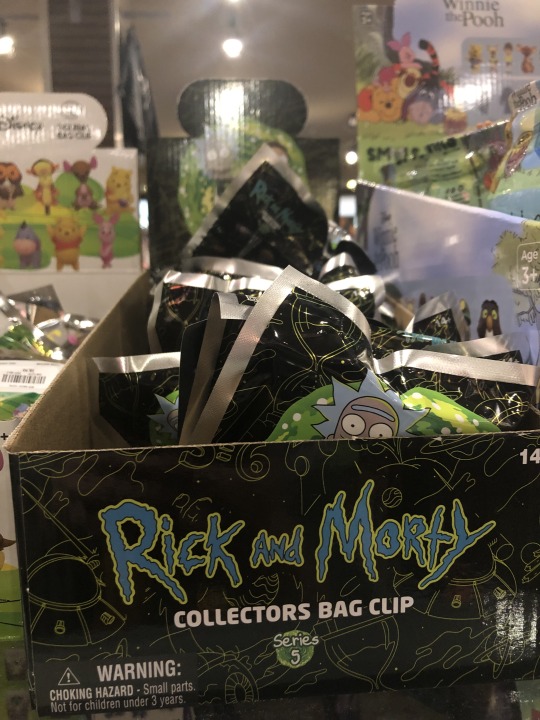
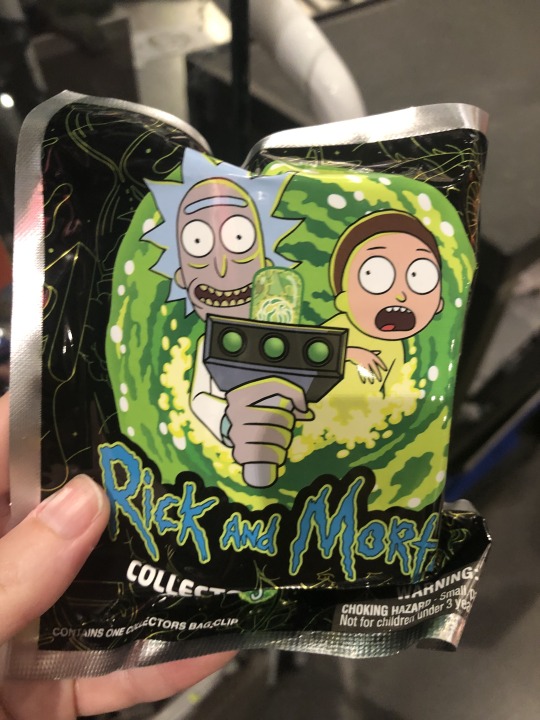
When I first saw the characters on the back, I thought "Oh, cool, we're finally catching up to season five." Then I found a surprise: Crow Witch Rick!!

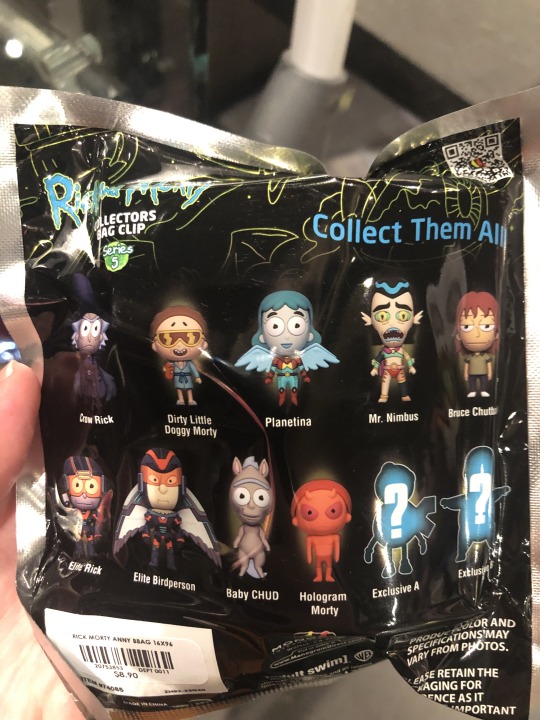
I wanted that little guy so badly, but the figurines are packaged so that you don't know what you get until you open one. I thought "He has a pointy hat, so maybe I'll be able to feel that inside the bag." I've heard of people using a similar method to find rare hockey cards.
But nope...no luck. Maybe I'll be able to find an opened one on eBay.
Also, it's funny how they're making "Rickdependence Spray" merchandise like that isn't the worst episode in the series. Admittedly, I did laugh at Morty's "dirty little doggy" line. But it wasn't worth it!

Hopefully, this means that more Crow Witch Rick merchandise is on the way because I would buy all of it.
Hot Topic also had another underutilized character: Philip J. Fry.
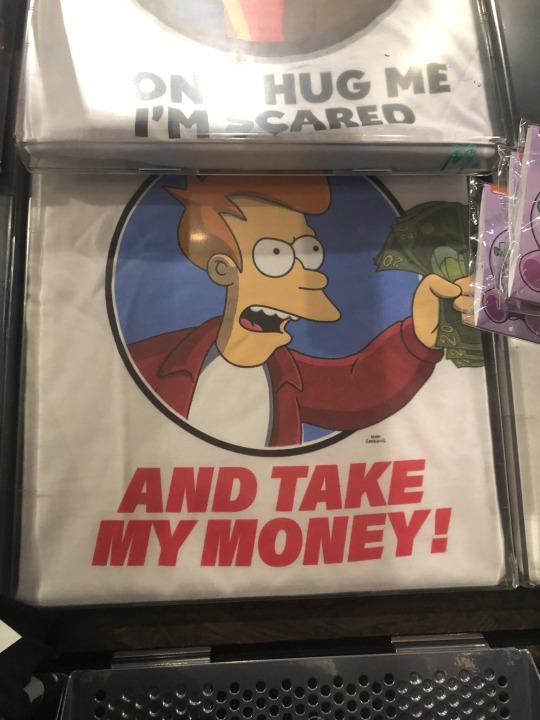
Futurama is weirdly under-marketed. The series has enough of a cult following that it seems like a cash cow, but merchandise is rare. I've always thought that Futurama is strangely underrated in general even though it's aired on two major networks and has one of the most famous cartoonists in the world behind it.
On to Spencer's. They didn't have Pickle Rick OR the Rick and Morty cube. Pathetic! But they did have a new wallet that looked like an old TV set, which is pretty clever.
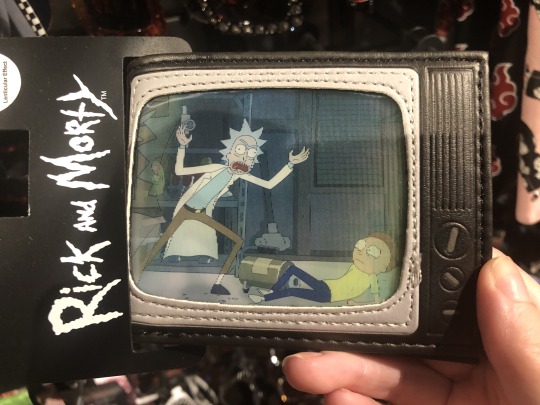
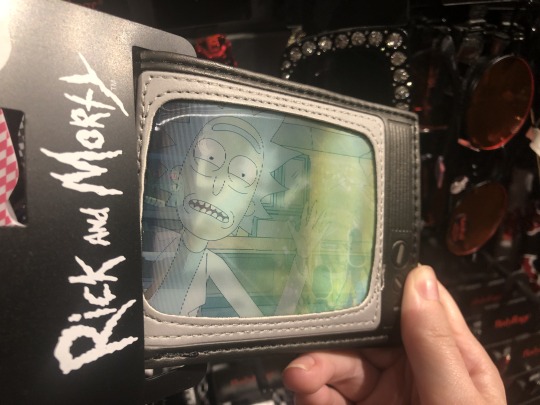

GIF of the changing image:

Today, it was time for a trip to the other mall. As always, I gave Box Lunch a little tip. Someone else requested the "will to live!" I don't think the mall can help them with that one.
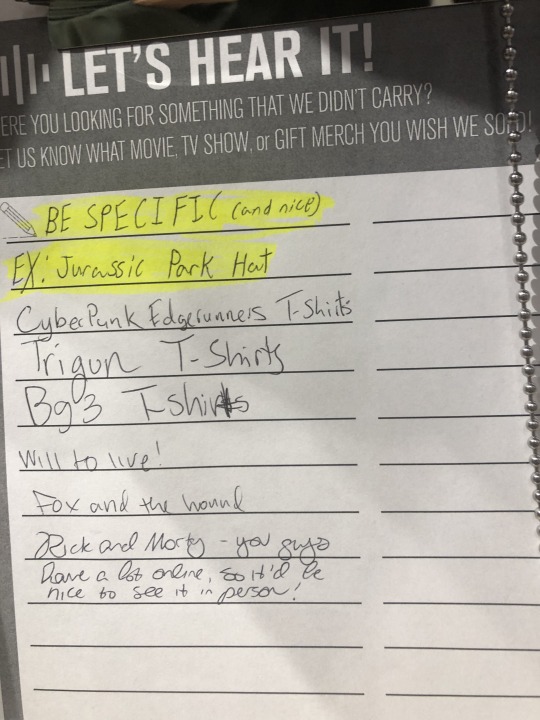
In the food court, I spotted a man wearing a Rick and Morty shirt. I said "Hey, your shirt is awesome! Can I get a picture?" He said "Yeah, sure." When I asked him where he got it, he said "Burlington."

So Burlington sells demonic Rick and Morty merchandise now? That's news to me.
The pile of Rick and Morty Funko Pops greeted me at one of the "nerdy" stores, but they're still slowly thinning out. I guess nobody wants the huge Snowball.
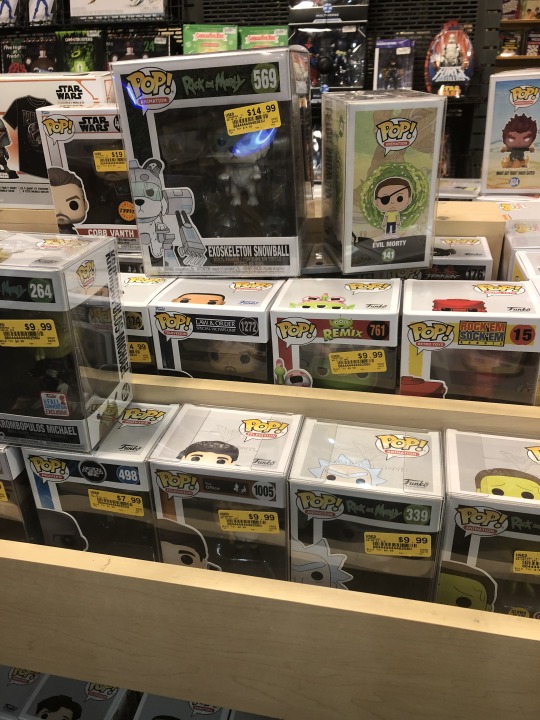
Similarly, I posted about this poor Froopyland Beth months ago, and she's still here. Nobody wants her!


And to make matters worse, there's an identical Froopyland Beth in a different part of the store who's lived there for months, too. They even lowered the price!

The store also has two identical King of Shit Rick Funko Pops, each with a different location and price.

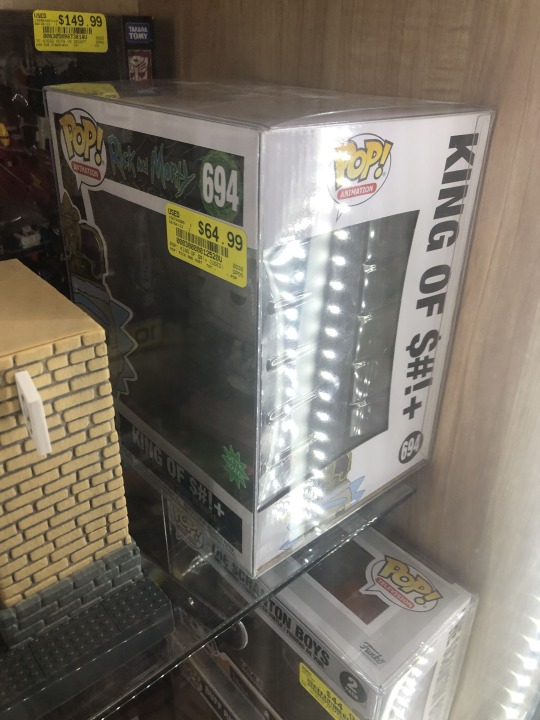
Don't want either of those? You can buy Rick in his ship if you're willing to reach to the top shelf.
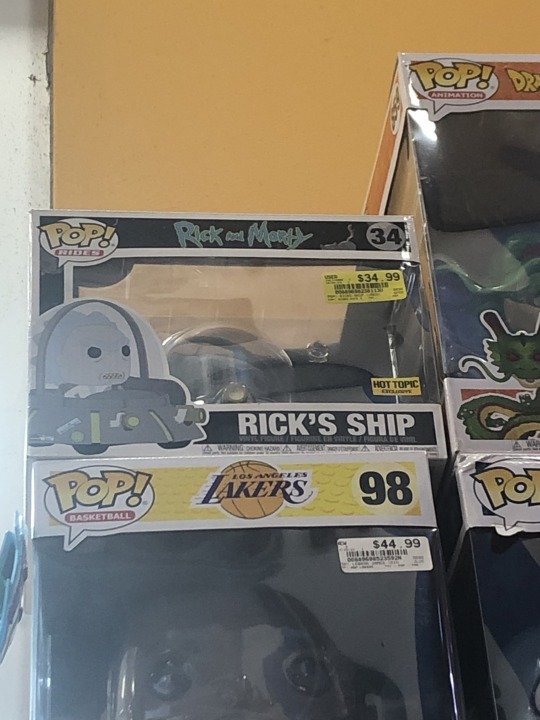
Look at him go!
THIS Spencer's location didn't let me down. Pickle Rick and the Rick and Morty cube were squeezed onto a shelf, albeit with a bat blocking the view.
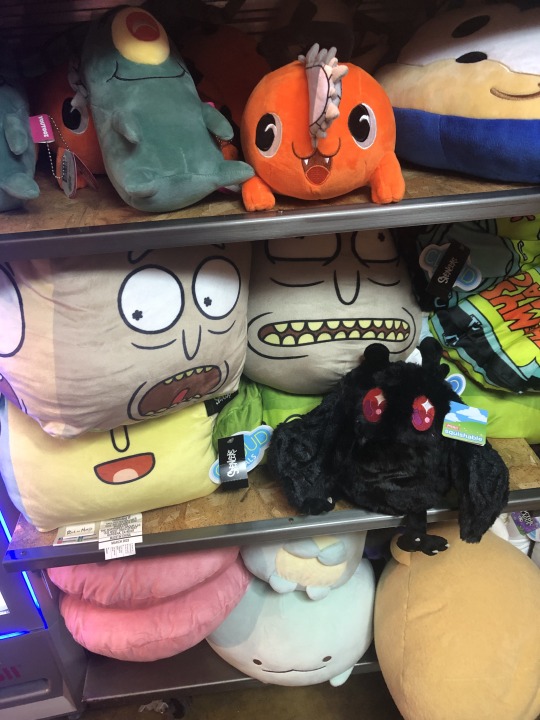
They also had a couple of new shirts. I love the vibrant colors.
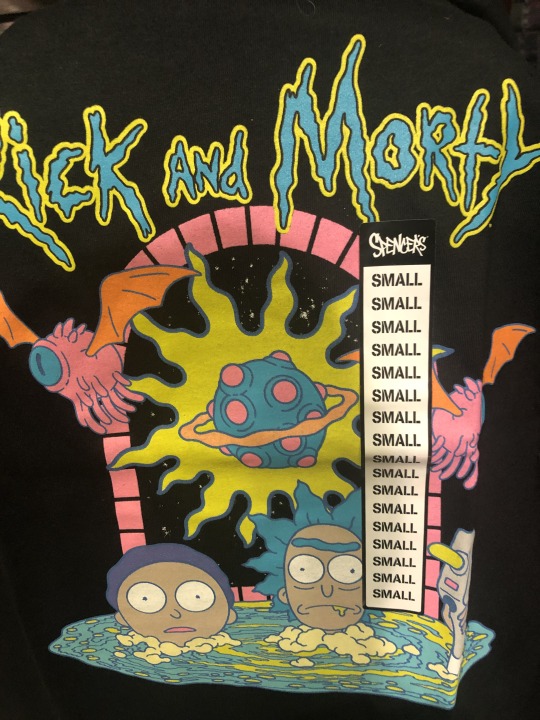
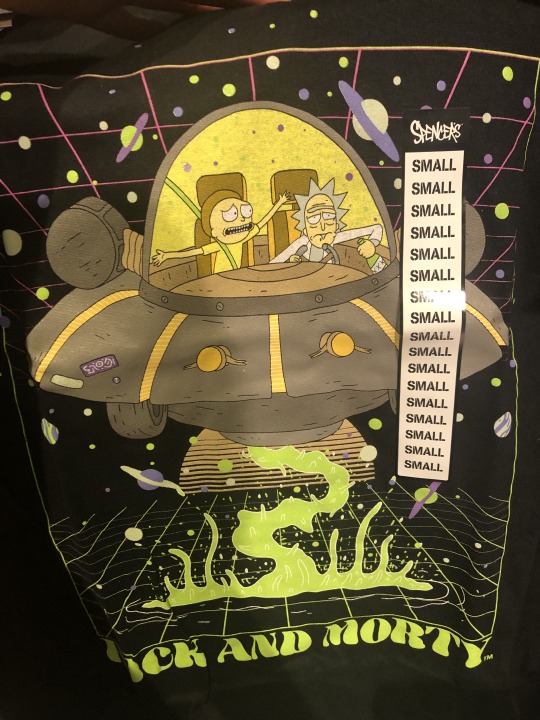
And a handful of comics in a different "nerdy" store.

No comics for me, thanks. Not unless they release a Crow Witch Rick one--and how has that not happened yet? Seems like an obvious way to expand on plotlines from the series.
Anyway, it'll probably never happen, but my dream is to get a Crow Rick figurine in this style. Maybe I'll hire someone to design and 3D print one.
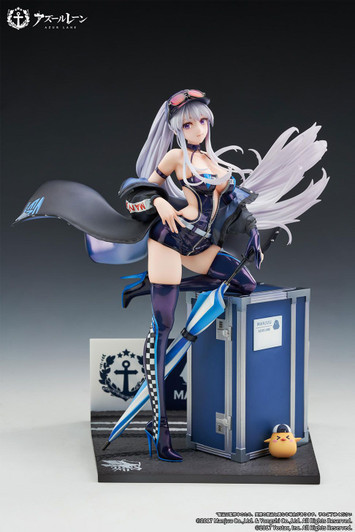

14 notes
·
View notes
Text
A thought
Cybernetics and 3d printing and regenerative medicine are going to overlap in a way that some may consider disgusting, but is actually absolutely fantastic.
Okay, so. Currently, we grow agricultural animals for food, and byproducts, like wool. Be it sheep wool, alpaca wool, llama wool, cow leather, horn, etc.
We do not currently farm some animals, despite their superior quality, because doing so is difficult. Like spiders for silk. Yes we do have silkworms and things, but it's not the same.
Nature and animals have manufactured exotic things just as a consequence of adaptation and survival for hundreds of millions of years, and some extremophiles have devised strategies that fit into nature yet offered absolutely surreal amounts of mastery over any given thing. Be it gecko feet being adhesive free super sticky pads, or camouflage, or what have you, or the strongest teeth in nature belonging to a SNAIL.
And they don't use exotic ingredients; they just use common everyday basic minerals and ways to express them at ultrafine molecular levels that make them biologically. So.. It stands to reason, someone that can organize and program proteins and cultures of meat, could program structures to grow these things in controlled conditions.
If you're not picking up what I'm putting down here, I think we're going to have 3d printers that use animal proteins as a base in a chemical nutrient sludge to start them, and then grow those special parts of an animal like they're on a mutant specimen that just so happens to only be, for example, a sheep's skin. So you grow these absolutely enormous sheets of wool uniformly without the necessity of taking care of hundreds of sheep.
Now, logically there's no need for that; you're fighting with agriculture for blankets and shit. Unless you're a psychotic vegan trying to crash the natural grown wool market and ruin profit margins for sheep herders, there are so many better, more exotic and difficult to acquire things you COULD be doing with the technology. For example, you could have the 3D bio-printer make snake venom to make antivenins. You could have this synthetic pit made of viper DNA that is just a gigantic venom gland, literally producing as much venom as the entire family of snakes produce in a year, or have ever produced since nature gave us snake with venom as a defense mechanism.
Isn't that fucking wild?
Or how about an entire tunnel lined with bacteria and acid producing pumps leading to an enormous series of artificial bowels that do nothing but turn food waste into forms of methane that can be sequestered and made useful, dealing with the problem of breaking down bio-matter without intense heat, fires, smoke, or atmospheric contaminants? Dealing with every bit of garbage for unutilized calories and preventing it from just producing millions of tons of methane in a landfill, which pound for pound/kilogram for kilogram can be worse for the atmosphere and the environment than millions of cars on the road? Because organic structures made to exist independent of an animal could do that.
In theory there'd be no biohazard elements, it'd be as dangerous as having a goat die. Yes there's some risk of bacteria and shit, but. it's just a dead body, not a nuclear wasteland.
And speaking of nuclear wasteland; What about artificially generated biological containers for bacteria that consume radioactivity? Imagine some sort of techo-organic GI tract that could consume the Elephants Foot faster than that bacteria have eaten it where it currently lays in Chernobyl. Nuclear waste that would've taken tens of thousands of years, or centuries after vitrification, gone in months.
Organic 3d printing is so much more than just the ability to rapidly fabricate cloned hearts, nerves or any other organ.
3 notes
·
View notes
Text
A Comprehensive Look at the 3D Food Printing Market Worldwide by 2028

Stay ahead of the curve with market analysis of the Global 3D Food Printing Market. Discover the latest insights in the evolving Global Food Printing Market.
#3D Food Printing Market#Global Food Printing Market#3D Food Printing Market Future#3D Food Printing Market Analysis#3D Food Market
0 notes